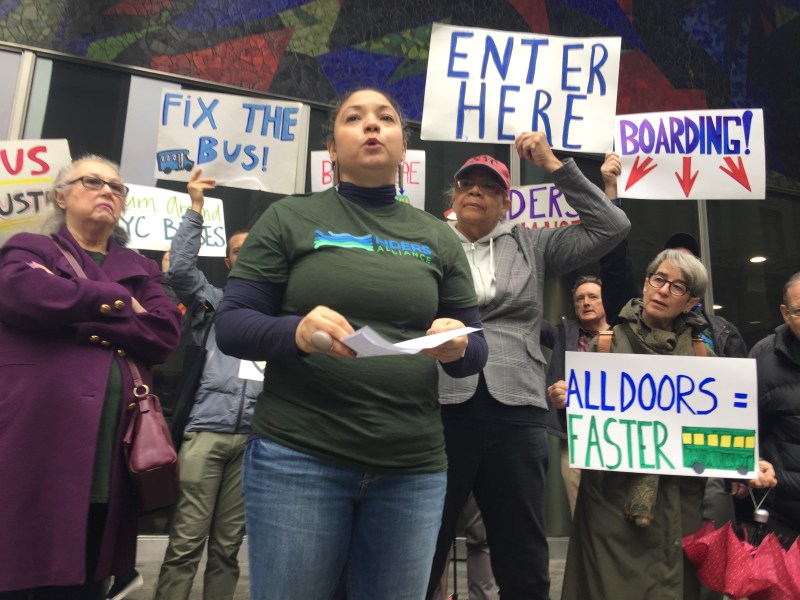The MTA’s Bus Action Plan Better Commit to Citywide All-Door Boarding
The agency says it will take "bold and radical steps" to turn around faltering bus service. To deliver on that promise, citywide all-door boarding is an absolute must.

On Monday, MTA bus chief Darryl Irick announced plans to take “bold and radical steps to really turn the bus system around.” The details of the strategy, he said, will be unveiled in “early spring.”
One element that absolutely must be in the plan is citywide all-door boarding, transit riders told the agency today.
Only a handful of the MTA’s bus routes enable all-door boarding, which speeds up service significantly. Cities including London and San Francisco implemented citywide all-door boarding years ago. Unlike in New York, where bus ridership is plummeting, a growing number of people are riding the bus in both of those cities.
This morning, volunteers with the Riders Alliance and NYPIRG’s Straphangers Campaign performed a brief skit outside MTA headquarters to demonstrate the absurdity of the current bus boarding process. They pushed and shoved to get to the front of the “bus,” while two other doors remained shut.
New York’s new transit fare system could speed buses and make them easier to use by allowing boarding by all doors. Should be Point 1 in @MTA’s new bus action plan @RidersNY #Busturnaround pic.twitter.com/5ElDG7G5S0
— TransitCenter (@TransitCenter) February 22, 2018
“What we just saw here might come off as an exaggeration for some, but it’s what New York’s bus riders are going through every day,” said Ramona Ferrerya, who often has no choice but to ride the bus because she suffers from a chronic illness. “During rush hour, dozens of riders end up pushing up against each other, and trying to shove their way through one door. Crowds wait at every stop, and boarding slows us down.”
In the fall, the MTA contracted with Cubic Transportation Systems on a fare payment system to replace the MetroCard. But the billion-dollar contract only commits to a test run of all-door boarding with the new fare tech, not citywide adoption.
Testifying before the MTA board today, bus riders laid out the importance of getting the boarding process right.
Slow boarding costs a lot of time, first of all, but it’s worse than that. On crowded routes, the race to the front of the bus turns into a demoralizing competition, with some riders shoving others to ensure they get on.
“Every day is a new adventure,” said South Bronx resident and Riders Alliance member Linda Scott. She’s often late to her destination because the bus is too crowded for her to board. “I let [the buses] go by because I don’t want to fight with other riders,” she told board members.
Travis Eby recalled a rainy day several years ago when his subway line was shut down so he opted to take a bus to a station on another line. At the bus stop, there were about 50 people waiting to board.
“We had to wait in the rain and the cold for riders to dip their MetroCards or count out change one-by-one, and then wait again at every subsequent stop,” Eby said. “The whole time I was thinking, ‘It doesn’t have to be like this, there’s another door.’ Can you imagine if we made subway riders queue up at the front of the train one-by-one?”





